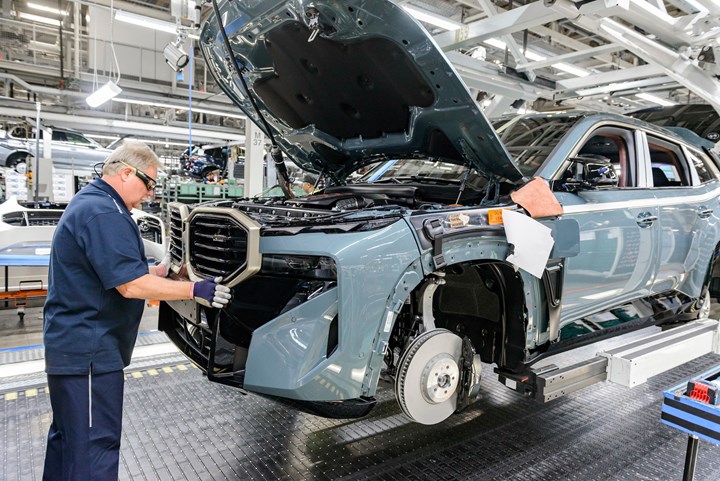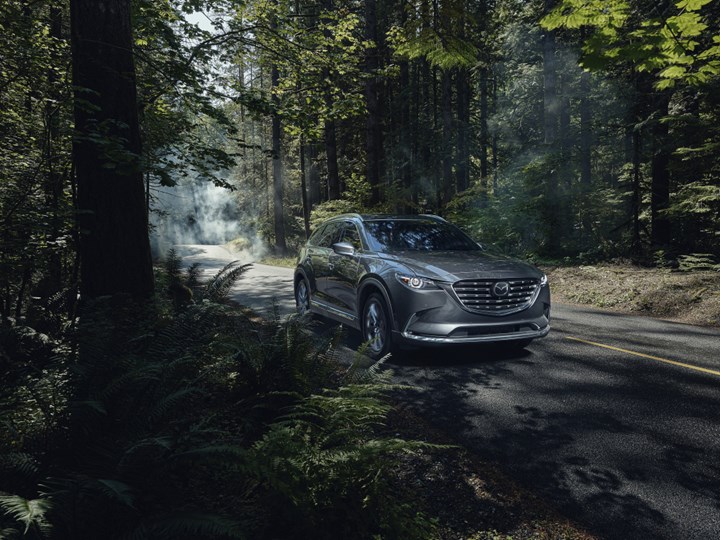on the BMW XM, EVs in India, Propulsion Dogs Prefer, Mazda CX9, Scottish SUV EV
BMW adds another SUV to Spartanburg production. . .Mopar’s holiday sweater. . .the growing number of electric miles. . .the economics of electric transition in India (relevant elsewhere, incidentally). . .dogs like EVs. . .Mazda CX-9. . .Scottish EV SUV built ag tough
XM in Spartanburg

The BMW XM in production at the company’s plant in Spartanburg, SC. (Image: BMW)
The BMW M1 was introduced as a concept sports car that would exhibit the Bavarian builder’s capabilities in 1975. The mid-engine car went into production in 1978. It went out of production in December 1980.
It was the first vehicle that was fully developed by BMW M GmbH. (While there are an array of BMW’s with the “M” designation, these are vehicles that are otherwise available non-M variants: e.g., the M3 based on the. . .3 Series.)
The M1 is a Giorgetto Giugiaro-designed race car.
The second BMW “M original” has gone into production at BMW Manufacturing in Spartanburg, South Carolina.
Another M
It’s the XM.
Last week, announcing the launch of the vehicle, Dr. Robert Engelhorn, president and CEO of BMW Manufacturing, said, “As the center of competence for X models, BMW Plant Spartanburg is prepared this vehicle with the highest premium quality that our customers deserve.”
And for those of you who are not familiar with BMW nomenclature, “X” signifies SUVs (although BMW likes to refer to them as “Sports Activity Vehicles,” which has not, and likely will not, catch on).
The Spartanburg plant is the global producer of the X3, X4, X5, X6, and X7 models.
BMW Spartanburg is, according to the U.S. Department of Commerce, the leader in automotive exports by value: 257,876 exports in 2021, for a total export value of >$10.1 billion. It has been the leader in that category for eight years running.
The world likes its SUVs.
Hybrid Power
The XM is a plug-in hybrid. Because it is a “M” vehicle, combines a 4.4-liter, 489-hp V8 and a 197-hp (a.k.a., 145 kW) electric drive for system output of 653 hp.
It is a full-size vehicle—201 inches long, 79 inches wide, 69 inches high, with a 122-inch wheelbase—with seating for five.
According to BMW it goes from 0 to 62 mph in 4.2 seconds.
The XM will be available in spring 2023.
The key markets will be the U.S., China and the Middle East—with the latter two undoubtedly helping boost that export value number from Spartanburg, as the XM has a starting price of $159,000.
///
Mopar: Ho-Ho-Oh!

When you love your vehicle and want to make sure your family and friends are really aware of it, this holiday sweater can be yours for $79.95. (Image: Mopar)
Mopar, the parts and accessories operation of Stellantis, has long been offering products from repair parts to things to personalize one’s ride (assuming said vehicle is a Chrysler, Dodge, Jeep, Ram, or Fiat). It has been doing this for 85 years.
It probably knows auto enthusiasts better than any other OEM-affiliated business.
That said, one wonders a little bit about the fashion sense Mopar Nation.
Not only is there the openly named “Mopar Ugly Holiday Sweater” shown above, but there are matching socks—a pack of two for $29.95.
To be fair, the holiday assortment includes somewhat more subtle Mopar wrapping paper and a Mopar tree ornament, as well as various less-striking pieces of clothing.
Still, considering that sweater you’ve got to think: People must really love Mopar.
(For readers in the U.S.: there is free shipping within the Continental U.S. with code FREEDEC100 on orders of $100 or more (that sweater and the socks would do it) until December 31. Act fast.)
///PEVs and Some Large Numbers

A growing number of miles driven with electricity. (Image: Argonne National Lab)
19.1 billion miles.
That’s how many miles “light duty electric vehicles using electric power” were driven in the U.S. in 2021, according to “Assessment of Light-Duty Plug-in Electric Vehicles in the United States, 2010–2021,” published by a group of researchers at Argonne National Laboratory.
The researchers added up all of the miles driven by PEVs—or “plug-in electric vehicles,” which combines plug-in hybrids and full electric vehicles—since 2010 and figured that 68 billion miles were achieved via electricity.
Note, however, that in 2021 the miles driven represent some 28% of all of the electric miles since 2010, which indicates a steep rise.
But those 19.1 billion miles represent <1% of the 2.9 trillion miles driven in 2021.
Clearly, PEVs have a way to go.
///
EV Fleet Transition in India and TCO

The Kinetic Safar Shakti electric delivery vehicle. Capable of a 100 km range. Has a loading capacity of 380 kg. Charging time is two hours (85 km; full charge: four hours). (Image: Kinetic Green)
India has the world’s largest fleet of two-and three-wheeled vehicles, according to the World Economic Forum (WEF). On the order of 250 million of these vehicles, which are used for both personal transport and commercial applications (moving goods and people). The vehicles account for more than 80% of all vehicle sales in India.
Electric versions?
Although there are some 45 certified manufacturers of EV versions in India, the WEF says their sales represents only about 1% of the scooters in use.
Making the transition from gasoline to electric in this segment would require financing of $285 billion, so odds are this is not something that will happen quickly, even with the support of the Indian government.
The government is operating a program, Faster Adoption and Manufacturing of Electric Vehicles (FAME), which provides financial incentives.
So Why Is This Interesting?
In “Financing India’s Electric Two- and Three-Wheeler Fleets,” the WEF authors write:
“Traditionally, the driver-cum-owner (DCO) model has dominated the two- and three-wheeler commercial fleets in India, but DCOs of commercial fleets are not yet comfortable to purchase EVs due to the higher upfront cost of acquisition, lack of confidence in new technology, unassured reliability and unestablished resale value.”
Which arguably are concerns (upfront costs, new tech reliability, resale value) that individuals and fleets have the world over for four-wheeled EVs, as well. If “charging infrastructure” was numbered among the concerns, it would almost track exactly with still considerable consumer resistance to going electric.
Drive and Save
The WEF shows some rather compelling total cost of ownership (TOC) figures for operating two-wheel and three-wheel vehicle fleets in Delhi, taking into account the FAME incentives. The two-wheel internal combustion engines (ICEs) primarily use gasoline; the three-wheelers compressed natural gas.
Two wheeler delivery:
- ICE: 2.4¢/km
- EV: 0.6¢/km
Three-wheeler delivery:
- ICE: 2.7¢/km
- EV: 2.3¢/km
As the WEF points out, “So, the more an EV is used, the cheaper it gets.”
///“Arf” Rhymes What Dogs May Do in a Car

Given a choice between transporting Fido in a diesel-powered vehicle or an EV, Fido would prefer the EV. So would you given what Fido might otherwise do. (Image: CarGurus)
In the late ‘90s Nissan ran a series of ads that featured a character, Mr K, who was modeled after the real Mr. K, Yutaka Katayama. He ran Nissan’s U.S. operations in the 1970s and is considered the “father” of the Z.
In the commercials for the Nissan Frontier back then, the whimsical, bespeckled Mr. K says with a bark, “Dogs love trucks.”*
Were those ads to be remade today, the line could be rephrased:
“Dogs love electric vehicles.”
And there is data to back it up.
Putting Dogs to the Test
In the U.K. CarGurus, an on-line automotive marketplace, and University of Lincoln, a public research university, conducted a study to determine how relaxed dogs were in an EV compared with riding in a diesel-powered vehicle.
There were 20 dogs involved. Each was taken on two 10-minute rides. One in each type of vehicle.
Daniel Mills, Professor of Veterinary Behavioural Medicine, University of Lincoln:
“Our results clearly show that dogs seem to be more relaxed in EVs, particularly when looking at behavioural traits such as restlessness.
“Additionally, an interesting and somewhat unintended revelation from the study came from the dogs that we identified as having potential symptoms associated with travel sickness.
“During their journeys in the EVs, biometric recordings of these dogs revealed their heart rates slowed markedly more than when they were in diesel cars. This was of particular interest to us given an increase in heart rate is commonly associated with motion sickness.
“It’s an intriguing result, which raised additional questions for exploration within this field.”
And This Is Relevant, Why?
According to the American Veterinary Medical Association, there are some 77 million dogs in the U.S. (other sources have even higher numbers).
Odds are, dogs are going to go for a ride more than a few times.
The researchers found that dog owners report that 44% of their pets get nauseous during rides.
What’s more, apparently there are what as described as “anecdotal concerns that the differences in vibration and/or noise experienced in an EV may cause to be unsettled or have increased car sickness.”
Which might have put some dog owners off the idea of getting an EV.
Evidently this study puts that to rest.
But why is the powertrain they compared against is a diesel. . . ?
==
*Katayama evidently loved life: he died in 2015, age 105.
///
2023 Mazda CX-9 Signature AWD

The Mazda CX-9: Something to consider when looking for AWD and three rows. (Image: Mazda)
This may be speculation, but I’d argue that it isn’t unwarranted:
Mazda has done a solid job as positioning itself as being a purveyor of excellent vehicles (i.e., design, ride and handling) that happen to be on the small side. Vehicles like the Mazda3 hatch. Or the MX-5—more widely known, still, as the Miata.
Which leads to consumers thinking: Interested in something small? Check out Mazda.
Let’s consider the dimensions of those two vehicles.
- Mazda 3 hatch: 107.3-inch wheelbase; 175.6 inches long, 70.7 inches wide, 56.7 inches high
- MX-5: 90.9-inch wheelbase; 154.1 inches long, 68.3 inches wide, 48.6 inches high
Small.
When the company offered the Mazda5 minivan, it took the “mini” part seriously:
- 2015 Mazda5: 108-inch wheelbase; 180.5 inches long, 69.9 inches wide, 63.6 inches high
To compare it with a contemporary competitor:
- 2015 Honda Odyssey: 118.1-inch wheelbase; 202.9 inches long, 79.2 inches wide, 68.4 inches high
The point of all this is that it would seem to me that if a consumer is thinking about buying a vehicle that is somewhat on the larger side, they are unlikely think of going to a Mazda dealer because, they think, it is a company that builds them on the smaller side.
And if that is, indeed, what they think, then those customers are likely to miss out on the CX-9, a three-row, seven-passenger CUV and will look at something like a Ford Explorer, Jeep Grand Cherokee L (it has the third row), Toyota Highlander, or Kia Telluride.
And the thing is, if someone is interested in the aforementioned attributes associated with Mazdas—expressive design, excellent ride and handling—they’re going to miss out on an opportunity.
==
While this is not entirely true anymore, some years ago a colleague asked an OEM executive that was launching a new SUV, “I can see the utility. Where’s the sport?”
The argument could be made that the CX-9 delivers on the sport and has less in the way of utility vis-à-vis some competitors in the midsize segment.
As for the sportiness, the vehicle is powered by a 2.5-liter turbo four that produces 227 hp and 310 lb-ft of torque (higher numbers in both cases when premium fuel is used, but really. . .). It is mated to a six-speed automatic.
Back in the mid-teens, there was a lot of discussion of Mazda’s SKYACTIV technologies, particularly in the powertrain field. Essentially the company’s engineers worked really hard at getting the most out of the least, in effect. Realize that Mazda is a company that is far smaller than the likes of Ford or Kia. So its engineers (and designers, and manufacturing personnel) have to do their utmost to leverage what they can. The SKYACTIV developments (e.g., getting the turbo to spool faster by putting a butterfly valve in the exhaust that narrows the orifice to increase the pressure) cleverly provided benefits. It wasn’t just a name that was used for brand equity.
This SKYACTIV approach also was deployed on chassis improvements such that the ride and handling of the CX-9 is something that you’d associate with—dare I say, in light of the opening of this piece—smaller vehicles.
Because the CX-9 is not a small vehicle:
- CX-9: 115.3-inch wheelbase; 199.4 inches long, 77.5 inches wide, 67.6 inches high
But one can’t get too carried away regarding litheness: it does weigh 4,409 pounds.
==
Now about the utility aspect in terms of carrying stuff. The room behind the third row (and, yes, it is a third row for small individuals) is 14.4 cubic feet. Fold the second and third and get 71.2 cubic feet.
To do a comparison with a Toyota Highlander (which I randomly selected), it offers 16 cubic feet behind its third row and 84.3 cubic feet behind the first row.
That’s where the CX-9 is wanting.
==
But one thing is absolutely certain: the interior execution—the materials, the designs, the ergonomics—are first rate.
And there are the driver safety assist technologies (adaptive cruise with stop and go; smart brake support; blind-spot monitoring; rear traffic alert; etc.) and infotainment (centered on a 10.25-inch color screen) amenities (there is complimentary Mazda Connected Services for three years, which allows monitoring and controlling the vehicle through an app) and more.
==
The CX-9 sales so far this year have been—all things considered—good. While through October its sales are off 13.8%, the Mazda3 is down 31.3% and the Miata down 50.7%, so in this regard it is smaller. And here smaller truly is better.
///
The Munro MK_1: An EV Truck Built to Take It

The Munro MK_1: A Scottish 4x4 EV built to last for the long run under even the most-demanding conditions. (Image: Munro)
Here’s something you’re not likely to hear from a CEO of a passenger vehicle company touting an all-new vehicle:
“The engineering is unashamedly agricultural in nature.”
That’s Russell Peterson, CEO of Munro Vehicles, talking about the Munro MK_1, which was officially unveiled this week.
The electric 4 x 4 SUV, available with either a 220-kW or 280-kW axial flux motor and either 61-kWh or 82-kWh Li-NMC batteries, has:
- 2,200-pound payload capacity
- 7,700-pound towing capacity
- 18.9-inch ground clearance
- 31.5-inch water fording capability
- 84-degree approach angle and 51-degree departure angle
- 148-degree ramp breakover angle
- Up to 16-hour off-road duty cycle
- Seating for five
Peterson continues:
"Some people see the term agricultural as potentially derogatory, but at Munro, we certainly don't.
“Agricultural vehicles feature some of the most sophisticated technology you can imagine. But above all, they are engineered to do the job, no matter how much punishment they soak up, and to keep doing it year after year. The Munro has been built to the most robust standards possible and to be fully operational in 30, 40, 50 years’ time.”
When is the last time you heard a CEO talk about a vehicle lasting decades?
Of course, this vehicle is admittedly more about work and less about being a daily driver.
Materially Different
While many new EV trucks have a “skateboard” chassis, the Munro has a galvanized steel ladder chassis made with 5-mm thick steel. Why this approach? To provide strength, robustness and ease of repairability.
The truck has laser-cut aluminum body panels.
“We’ve used thick plywood for the lining of the cargo area. It gives a nice definition between the steel and aluminum material, but more importantly, it’s tough and extremely hard-wearing. To ensure the cargo stays secured, we’ve used aluminum tracks and fastenings, each of which is strong enough to hold 400 kg of weight in place,” says Peterson.
About the Design
Head of Design for Munro is Ross Compton.
His approach to the truck, which is clearly not baroque eye candy when it comes to exterior execution:
“Just as a good engineer will always strive to create the simplest solution, we have endeavored to keep the design as elegant as possible. At no point have we prioritized visual appeal over purpose.
“We are totally comfortable with the minimalist nature of the Munro’s design. Ninety nine per cent of what you can see on this truck is there because it serves a function—and nine times of ten it serves more than one function as well.”
Compton adds:
“We have made it very clear that the Munro is focused entirely on providing the world’s best emission-free off-road driving experience. But we are equally aware that not all our customers will be farmers and mountain rescue drivers, and we are entirely comfortable with that.
“We are confident that the Munro’s classless design will look just as good in Richmond London [a swanky residential area] as in Richmond Yorkshire [a market town: think of the setting for All Creatures Great and Small].”
Munro is building its vehicles in Scotland. In 2024 it plans to move to a purpose-built production facility that will initially have a capacity of 250 vehicles per year (it plans to build 50 in 2023), going to 2,500 per year by 2027.
><><><
RELATED CONTENT
-
On The Jeep Grand Cherokee, 2022 Nissan Pathfinder, and More
An inside look at the Detroit Assembly Complex-Mack; a innovative approach to waste-free, two-tone painting; why a forging press is like an F1 car; and other automotive developments.
-
On Automotive: An All Electric Edition
A look at electric vehicle-related developments, from new products to recycling old batteries.
-
Revolutionary Hydrogen Storage Tank Design Could Propel H2 Deployment
Rather than storing hydrogen in a large cylindrical tank, Noble Gas has developed a conformal system


.jpg;width=70;height=70;mode=crop)






